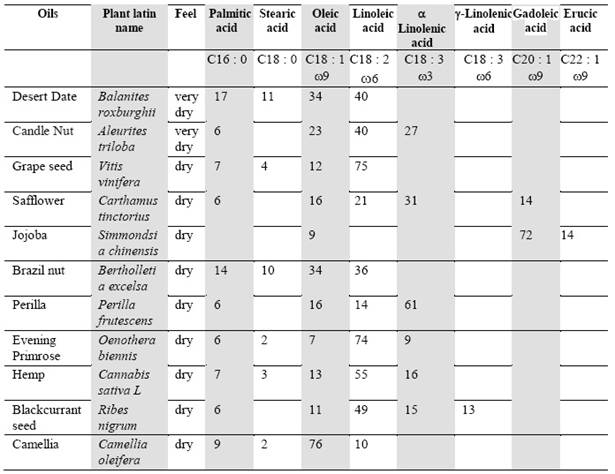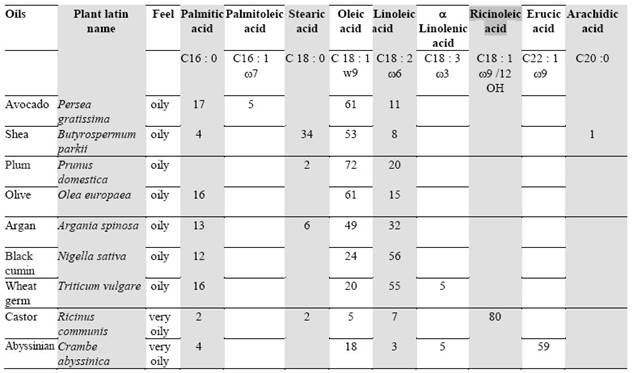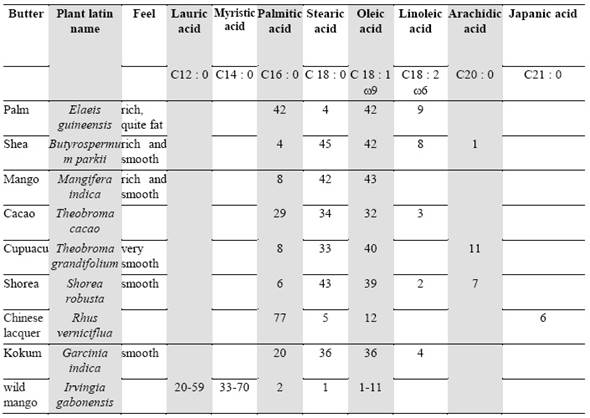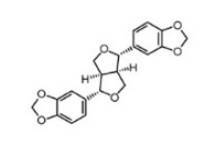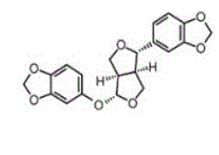INTRODUCTION
The first fats used on the skin by humans were of animal origin. They were used to disperse and apply bodily decorations and to soothe and heal surface wounds. Chemical analysis has very recently revealed that a pot buried with a Chinese nobleman some 2,700 years ago held a skin cream made from ruminant adipose fat mixed with monohydrocalcite, a mixture that was probably foundational to China’s cosmetics at that time 1. With the rise of civilisations, oils and waxes gradually became used in skincare, first among the Egyptians, then in traditional pharmacopoeia. Relatively insensitive to bacterial contamination and occlusive, they became the basis of ointments, liniments and salves. Gradually, they were mixed with minerals such as ceruse to whiten the skin, or with plant extracts to heal. The formulas were difficult to apply and relatively unstable to oxidation. More than four centuries ago, fats were also used in Europe as a carrier for perfumes to coat leather and give it an acceptable scent. Apothecaries and perfumers tried their hand at complex mixtures. Improved cold cream was created but the products remained unstable, oxidisable and short-lived. With the gradual development of solvent extraction technologies, oils demonstrated more acceptable stability and organoleptic properties. Numerous French chemists and pharmacists played a decisive role in the physicochemistry of fats, including Darcet, Chevreul, Pelouze, Gobley and Mège-Mouriès, not to mention Baudrimont from the same era who, in his famous dictionary, described the main falsifications and alterations of fats 2),(3. The progress of 20th century chemistry led to the emergence of synthetic surfactants and petroleum derivatives which were the preferred components for stable emulsions that leave a pleasant feel on the skin 4.
FATS AND THE SKIN
Skin is the outermost layer of the human body and protect the body from harmful substances, pollution and ultraviolet A and B radiations. Skin thickness, 0.5 mm thick on the eyelids to 5.0 mm on other parts of the body, varies considerably between different ethnic and age-groups, between men and women, and the different regions of the face and body surface. Skin is a very complex tissue. containing resident and immune cells, extracellular matrix, protein fibers, sebaceous glands, nerves, blood and lymphatic vessels, sweat glands, nerve endings to record pain; sensory cells at the ends of nerve fibers, sensory sensors for heat, cold, tactile stimuli and pressure. Thanks to all its complexity, skin performs various functions in response to the environmental stress, informs brain and has an important societal role in maintaining attractiveness. Substantial recent research on the composition and organisation of the various lipids responsible for the skin barrier rationalises the use of fats on the skin to enhance or care for it 5),(9. The hydrolipidic film on the surface of the skin is mainly made up of sebum comprising triglycerides, squalene, free fatty acids mixed with sweat secretions, shed skin cells (corneocytes) and the surface microbiota 10. The composition of this film follows the variation in sebaceous or sweat gland density, the presence of hair follicles and local hormone receptors levels. The nature and phase organisation of the lipids forming the stratum corneum's inter corneocyte cement vary according to season, nutrition, depth, area of the body and the condition of the healthy or pathological skin. The consensus is that three classes of lipids, free fatty acids, sterols and ceramides are essential to the cohesion of the stratum corneum and the skin barrier 11. The membranes of non-differentiated human cells in the living epidermis and dermis are made up of complex proteo-lipid domains which, through their physicochemical dynamic, regulate the intercellular messages necessary to biological reactions. Last but not least, the adipocytes in the hypodermis are rich in hormones, growth factors and energy.
FATS AND COSMETIC FORMULAS
Cosmetics are intended for healthy skin with their main purpose to enhance and protect. Unlike a dermatological product which works through an active ingredient formulated in an excipient that is neutral by definition, in cosmetics, the whole formula is involved, and the notion of excipient does not exist. Fats are mainly found in liquid dispersed forms, powders and solid forms of makeup such as lipstick, eyeshadow or mascara. In a cosmetic emulsion, the term "fatty phase" refers to all the compounds that are not soluble in water, forming the dispersed phase in an oil-in-water (O/W) emulsion or the continuous phase in a water-in-oil (W/O) emulsion. It allows the incorporation of the formula's fat-soluble ingredients, ingredients with biological activity, preservatives, lipophilic UV filters, perfumes, pigments, etc. Oxidation, hydrolyze, crystallization, temperature sensitivity and undesired blooming (migration to the surface) are the most common problems encountered with the use of natural ats in formulation 12),(13.
Fats, oils, waxes and esters are key elements in the skincare and makeup textures and are mainly used as emollient, nourishing, solubilizers, consistency and dispersing agents. The entire formula is responsible for the sensory effect and cosmetic activity of the film, colored or not, that remains on the skin after application. Today, cosmetics mainly use mineral or synthetic oils for their highly reproducible composition, purity, refractive index, lack of color and the slipperiness and softness they bring to the skin. So-called hydrocarbon oils are esters or alkanes and used for their pigment dispersion and wetting properties. Until recently, cosmetics mostly used neutral mineral waxes, which are highly compatible with other fats and give consistency to formulas. These include ceresin, ozokerite and polyethylene waxes. Sustainability is presently a key driver in the cosmetics industry and the beauty sector overall. The cosmetic industry develops in all its dimensions an eco-design approach, especially in the use of more natural and sustainable ingredients. The gradual closure of refining sites in Europe and the demand for natural offerings are forcing formulators to turn to sources other than paraffinic derivatives. Some vegetable raw materials are used in the synthesis of solubilizers, surfactants and stable components similar to mineral oils. Today, the wide range of fatty acids in vegetable oils and the demand by users for more natural, even vegan products have led to their comeback in products on the market.
This article reviews the chemistry of vegetable oils, natural waxes and esters, the main fats used in cosmeticology.
CHEMICAL COMPOSITION OF OILS
Oils can be defined as natural esters of glycerol which are liquid at room temperature, fats being solid at room temperature. Vegetable oils from terrestrial plants consist mainly of triglycerides (95-98%) and mono and diglycerides (1%) with micronutrients, particularly molecules like tocopherols and/or polyphenols. Saturated fatty acids are often found in position 1 and 3 of glycerol and mono or polyunsaturated fatty acids in position 2. The wide variety of chemical structures in fats, especially the nature and percentage of fatty acids, gives them their rich organoleptic, physical, chemical, biological and skin barrier modulation properties. The most sought-after fatty acids are essentially unsaturated fatty acids, giving rather liquid products at room temperature or saturated ones giving semi-solid or solid products. Mainly unsaturated fatty acids are oils while saturated fatty acids are "butters". All these compounds are extracted from the seeds, nuts and fruits of plants using solvent for green extraction such as Pressurized liquid extraction (PLE), Supercritical fluid extraction (SFE). Microwave assisted extraction (MAE), Ultrasound assisted extraction (UAE), Enzyme assisted extraction (EAE)…
In most fats, the greater part of nonglyceride portion is removed by hydration or by reaction with alkaline during the course of ordinary refining. This treatment is used to eliminate undesired fatty acids and partially sterols, carotenoids pigments, degum or improve the olfactive stability of the material 14.
Among the monounsaturated fatty acid-rich oils traditionally used today are olive oil (Olea europaea), sunflower oil (Helianthus annuus), macadamia oil (Macadamia integrifolia), avocado oil (Persea gratissima), sea buckthorn oil (Hippophae rhamnoides), castor oil (Ricinus communis), calendula oil (Calendula officinalis), etc. Polyunsaturated oils rich in linoleic and linolenic acids include argan oil (Argania spinosa), amaranth oil (Amaranthus cruentus), echium oil (Echium plantagineum) and Japanese white pine oil (Pinus parviflora). The oxidation of unsaturated fatty acids, once extracted from their natural protective environment, causes an autocatalytic radical reaction, leading to organoleptic and discoloration degradation known as rancidity. High level of unsaturation, light and temperature are accelerating factors but are neither necessary nor sufficient to trigger oxidation phenomena. The main parameters necessary to the formulation are moisture content, melting point, cloud point, saponification number, acid value, free fatty acid content (rancidity), iodine (degree of unsaturation) and peroxide value (formation of primary oxidation products).
Cosmetologists have renewed their interest in plants of marine origin in recent years. Marine microalgae lipids are rich in polyunsaturated fatty acids (PUFA): arachidonic (C20:0), linoleic (C18:2) and linolenic (C18:3) acids are found in several species of microalgae (Isochrysis, Skeletonema, Thalassiosira). In addition to these essential fatty acids, microalgae are rich in eicosapentaenoic acid (EPA, C20:5) and docosahexaenoic acid (DHA, C22:6), two highly unsaturated fatty acids from the omega-3 series 15. Microalgae synthesise EPA and/or DHA in varying relative proportions depending on their taxonomic class. On the other hand, for the same species, the content of these fatty acids is strongly dependent on the growing conditions.
Bio-sourced algal oil can also be produced by algal biofermentation of simple sugars derived from sugar cane which are converted into oils (triglycerides) with minimal environmental impact. This triglyceride principally contains three chains of oleic acid (C18:1) with very low polyunsaturated fatty acid content, which gives it good oxidative stability and therefore a long shelf life. This algal oil is a “natural ingredient” according to ISO 16128, easily biodegradable, and fully traceable 16. It contains more than 90% omega-9 (triolein). It is used in hair care products. It protects the hair fiber from breakage, repairs split ends and creates shine.
Vegetable oils have known benefits for the hair: linoleic acid (omega-6) minimises water loss from the hair with softening and nutritional qualities, gamma-linolenic acid (omega-3) has anti-inflammatory properties in addition to maintaining hair elasticity and calms scalp irritation, and oleic acid (omega-9) has nourishing properties, making the hair softer, more supple and more radiant.
DRY OR FATTY VEGETABLE OIL?
When applying a vegetable oil to the skin, a greasy sensation may be experienced. This is due to the fatty acids in the oil, which makes it relatively easy to spread and helps it to penetrate into the stratum corneum. The more affinity the oil has with the skin, the faster it penetrates and the less greasy you feel. These vegetable oils, which penetrate the skin and do not leave a greasy film behind, are called "dry oils". Dry oils are mainly composed of omega-3 and omega-6 fatty acids, which penetrate the skin more easily, while so-called fatty oils contain more omega-9. The term "dry oil" is something of a misnomer, referring more to the sensory effect perceived after application than to an objective criterion (17). In the formulation of cosmetic products, vegetable oils are chosen according to the desired texture, possible interactions with other ingredients, their specific properties (linked to the presence of unsaponifiable fractions, essential fatty acids, etc.) and the image provided by the original plant, which plays a role in the sales pitch.
These vegetable oils are traditionally used in many cosmetic products (day creams, night creams, lotions, lipsticks, shampoos, etc.) with 204 million tons produced globally in 2019/2020 (18).
BUTTERS
Butters and waxes are also commonly used in cosmetic and toiletry products. Pressed powders, such as eyeshadows or blushes use also fat’s mixtures as binder to increase the powder particle dispersion, wettability, cohesiveness during compaction and their final adhesion on skin. Of the oils rich in saturated, semi-solid fatty acids, often referred to as butters, the most commonly used are palm (Elaeis guinensis), coconut (Cocos nucifera), shea (Butyrospermum parkii), mango (Mangifera indica), cocoa (Theobroma cacao), cupuacu (Theobroma grandiflorum), shorea (Shorea robusta), sumac (Rhus verniciflua) and wild mango (Irvingia gabonensis) from the world's tropical regions. These materials must meet the criteria set out in the Nagoya Protocol on Access to Genetic Resources and the Fair and Equitable Sharing of the Benefits Arising out of their Utilization (19), (20).
The intensive production of palm, coconut and cocoa oils has had a major impact on biodiversity loss. Sustainable chains have been developed but consumers continue to view these oils with a critical eye. They are used in the manufacture of soaps or as intermediates of functional compounds (methyl ester) for the manufacture of surfactants. Small variations in the composition of butters affect their crystallisation, internal microstructures, mechanical properties and interactions with other components in a formula.
Coconut oil is known for its use in the traditional Monoï de Tahiti preparation. Shea butter, which comes from the fruit of the shea tree, predominantly found in Africa, is made up of a complex mixture of stearic, oleic, palmitic and linoleic acids and unsaponifiable fraction (around 8%, sterols and terpenes) which give it its consistency, emollience and mechanical wrinkle-filling effect. It is softer than Shorea butter from India, which is used in sticks and products for dry skin. Kokum butter is very rich in stearic and oleic acid, has a very hard consistency, is astringent and is used in lipsticks and lip salves for the surface "ulcerations". Copra butter or coconut oil should be restricted to foaming emulsions and sun protection formulations. Cupuacu butter, which originated in pre-Columbian civilisations and is extracted by continuous mechanical pressure from the seeds, is rich in oleic, stearic and arachidic acids. It melts in very easily, does not make the skin shiny and is recommended for the formulation of hair masks and lip care. Cupuacu butter contains triglycerides and phytosterols (β-sitosterol, stigmasterol, campesterol) with a balanced composition of fatty acids, hence an extremely low melting point (around 30°C), and a high-water absorption capacity. It can be found in creams, lip products, bath oils, aftershave lotions, sunscreens and deodorants 21),(22.
Mango butter, balanced in saturated and unsaturated acids, is fairly emollient, prevents the skin from drying out and protects against UV rays via an antioxidant effect (tocopherol). The triglycerides of myristic and lauric acids from the wild mango tree make it a natural lipid-replenishing, softening butter that can be used in make-up, skincare and hair preparations. Jojoba esters have an intermediate butter like texture, low greasy emollient properties, a good temperature /oxidative stability index and some similar rheological properties of less natural wax /volatile oil mixture used in eyeshadows formulas 23.
WAXES
Waxes are complex mixtures formed predominantly of esters, which are mostly solid at room temperature, with a high melting point and found on the leaf surface of certain plants and whose role it is to protect them. They look harder, more brittle than fats and often soft semi-solid.
In waxes, a distinction is made between wax esters which are essentially fatty alcohol esters with a long-chain fatty acid, and steroids or esters of sterols with a fatty acid chain. Waxes form crystalline structures, creating gelling properties, increase the viscosity of textures and have lubricating properties. They are widely used in make-up products, lipsticks, mascaras, etc. With their widely varying compositions, melting points and crystal structures, their applications, oxygen permeability and plasticity can be regulated. "Jojoba oil" (actually a wax) has very long-chain wax esters (36 to 46 carbon atoms) is derived from Simmondsia chinensis, carnauba wax is derived from a Brazilian palm tree, and the very hard and highly shrinkable Candellila wax is cold-extracted from an euphorbia plant. Beeswax, although derived from the work of domestic bees, is also widely used in cosmetics for its significant oil-absorption capacity.
Carnauba wax:
This wax comes from the leaves of a Brazilian palm tree Copernicia prunifera. It predominantly contains C20-C30 fatty acid esters with long-chain alcohols (85%), accompanied by acids, free alcohols, hydrocarbons and resins. Offering consistency and shine, it is used to formulate lipsticks and stick deodorants 24.
Candelilla wax:
Purified shiny wax from the leaves of an euphorbia plant (Euphorbia antisyphilitica) which is now protected. This wax is formed predominantly of hydrocarbons (around 50%, C29-33 carbons), esters (20-29%), free acids (7-9%) and resins (12-14%, mainly triterpenoid esters) with a high melting point. Candelilla wax is used as an emollient, thickener and solidifying agent to give a relatively firm texture to finished cosmetic products.
Sunflower wax:
With very strong gelling properties at low concentrations (0.5%), sunflower wax (Helianthus annuus) consists of C36 and C54 esters (65%) (C40-C44 often the majority), fatty acids (16%) and C18-C32 free fatty alcohols (10%) (including lignoceryl and cerotyl). It is also highly crystallised 25 and used in lipsticks, mascaras and balms.
Rice wax:
Rice bran (Oryza sativa) wax is purified and refined from the various fats surrounding the natural crystals following by winterization process of the rice bran oil. It has a melting point of around 80°C, comprises a mixture of C22 behenic (or docosanoic) acid (16%) and C24 lignoceric acid (40-45%), and contains long-chain esters (fatty alcohols). Rice bran wax is cheap and widely available26. It has excellent oil gelling properties and a substitute for beeswax to make softer and creamier emulsions. This "hardening" wax can replace Carnauba (82-86°C) and Candellila (69-73°C) waxes in lipsticks thanks to its high melting temperature.
UNSAPONIFIABLE MATTER
The term "unsaponifiable" was coined by the French Chemist Michel-Eugène Chevreul in the 19th century and refers to the non-glyceride part of a vegetable oil, i.e. the part that cannot be saponified. The unsaponifiable fraction is not made up of fatty compounds. It represents just a few per cent of the weight of the oil but it contains some of the substances that give the oil many of its main characteristics, i.e. its colour, aroma and flavour, as well as other properties beneficial to health and the skin, such as antioxidant and anti-inflammatory properties. The unsaponifiable fraction of a fatty substance refers to all of its constituents which, after basic hydrolysis (saponification), are very slightly soluble in water and soluble in organic solvents.
COMPOSITION OF UNSAPONIFIABLE FRACTION
Squalene
Squalene is a triterpene, with thirty carbon atoms and fifty hydrogen atoms. It can account for up to 40% of the weight of the unsaponifiable fraction. It takes its name from "shark" because shark liver oil was one of the main sources of squalene.
It is a substance that the body produces naturally. Squalene, present in high quantities in the sebum on the surface of the skin, works to keep the skin hydrated, allowing it to retain its elasticity and surface flexibility.
β-carotene
β-carotene is a precursor of vitamin A, an essential vitamin in epidermal regeneration. Its long chain of conjugated bonds makes it a popular fat-soluble antioxidant that works to protect cells from free radicals. The β-carotene gives the oil a yellow-orange tone.
Tocopherols and tocotrienols
Tocopherols are grouped under the generic name of vitamin E, which consists of a chromanol group and a 16-carbon saturated phytyl side chain. The number and position of methyl groups on the chromanol nucleus define the different forms α, β, γ, δ. α-tocopherol, the most common in nature, is believed to have the most significant vitamin activity. β and γ are said to have less vitamin activity with δ practically inactive. α-tocopherol or vitamin E is a powerful natural antioxidant agent as well as naturally protecting fats from oxidation. Its main biological function is to protect the body from the harmful effects of free radicals produced during normal metabolic processes and through environmental factors 27. Tocotrienols, a rare form of vitamin E, is used to efficiently protect UV damages, differ chemically from their tocopherol counterparts by the unsaturated character of their terpenoid side chain, hence their name in -trienol, but provide physiologically an equivalent antioxidant function thanks to the labile hydrogen atom of their hydroxyl -OH.
Polyphenols
Polyphenols include simple phenols, phenolic acids, coumarins, flavonoids and polymerized forms such as tannins and lignin. They are responsible for the aroma, colour and antioxidant properties of plants used as active ingredients in cosmetics 28.
Not all vegetable oils and butters are suitable for the production of unsaponifiable matter; some do not have it, others do. Here are some examples:
Avocado unsaponifiable matter:
Avocado unsaponifiable matter is a brown, fatty, pasty mass containing many substances, derived from the avocado oil of Persea gratissima Gaertn or Persea americana Miller. Its composition varies but it mainly contains tocopherols, which give avocado oil its stability, terpene and aliphatic alcohols, sterols and hydrocarbons. Persea americana is said to have various biological properties: antiviral, antioxidant, antimicrobial, anti-inflammatory, etc. These properties are due to the presence of many natural phytochemicals, such as tannins, alkaloids, phenols, saponins and flavonoids 29.
Soya unsaponifiable matter:
Soya unsaponifiable matter is derived from the soya oil of Soja hispida Maxim. or Glycine max Merr. The unsaponifiable matter contains sterols: β sitosterol (47-59%), stigmasterol (17-19%), campesterol (19-23%), avenasterol (2-4%), as well as the tocopherols that mean it is used for its antioxidant activity 30.
Olive oil unsaponifiable matter:
Although less than that of shea butter, olive oil (Olea europaea L) unsaponifiable matter makes up a significant fraction: about 0.5 to 2%. This is mainly made up of hydrocarbons, including squalene (approximately 80%), in addition to the substances traditionally found: triterpenic alcohols, phytosterols and tocopherols. There are also some carotenoids.
Tomato seed oil unsaponifiable matter:
Derived from the seeds of a solanaceous plant (Solanum lycopersicum), it contains tocopherols, sterols and carotenoids (trans-lycopene, cis-3-lycopene and β-carotene), giving it an antioxidant action 31.
Sesame oil unsaponifiable matter:
Derived from sesame seeds (Sesamum indicum), it is rich in tocopherols and sterols, including β-sitosterol (59-62%), stigmasterol (9-7%), campesterol (18-19%), and sesamin and sesamolin with antioxidant activity.
Some suppliers to the cosmetic industry have developed cosmetic raw materials rich in unsaponifiable matter that claim biological activity. Thus, an extract of sunflower oil rich in unsaponifiable matter (> 5%) is presented as a stimulator of key lipid synthesis in the skin barrier by activating PPARs (Peroxisome Proliferator Activated Receptors). These intra-cellular receptors, expressed in the epidermis, play a major role in maintaining the skin's barrier function. Their activation leads to the stimulation of skin lipid synthesis and anti-inflammatory activity 32.
FATTY ALCOHOLS
The history of fatty alcohol production dates to 1817 when cetyl alcohol was isolated by M. E. Chevreul as a component of a solid wax ester from the skull cavity of the sperm whale. The term fatty alcohol refers to a range of aliphatic hydrocarbons containing a hydroxyl group, usually in the terminal or n position. Cosmetic products composition is described in the International nomenclature of cosmetics Ingredients or INCI. Long-chain aliphatic alcohols are widely used in the personal care industry. All INCI "alcohol" names preceded by a word ending in "-yl" are fatty alcohols. They are obtained through a process of reducing the carbonyl function of a vegetable oil, coconut oil or palm kernel oil. Cetyl alcohol (C16OH), a straight-chain fatty alcohol with 16 carbons, is considered one of the most versatile and is currently used in cosmetics, some shampoos and as a raw material in surfactant manufacturing. C16 fatty alcohol, palmityl alcohol and 1-hexadecanol are generally used as non-gelling thickeners, co-emulsifiers and emollients. Lamellar gel networks are creamy formulations widely used in cosmetics. The basic units of these networks are lipid bilayers assembled from mixtures of fatty alcohols, surfactants and water at a temperature of between 50 and 70°C 33.
FATTY ESTERS
In the cosmetics industry, emollients provide a greasy surface film, soften the skin, improve elasticity, reduce insensible water loss (IWL) and disperse pigments. They have become an essential group of ingredients for formulators.
Fatty esters are synthesised through either conventional esterification, acidolysis, alcoholysis, glycerolysis or even transesterification to obtain well-defined products. The raw materials used for esterification are acids and alcohols. This family of raw materials is very broad, with short and long chains: from C2 to C22 for acids and from C1 to C32 for alcohols, with linear or branched, saturated and unsaturated chains, multi-functional acid chains (12-hydroxystearic acid, etc.), polyol-type alcohol chains (glycerol, propylene glycol, etc.), and sugar-type alcohol chains used during transesterification, a process used to synthesise sucroesters. Acidic raw materials or alcohols of vegetable origin come from vegetable oils (palm, palm kernel, copra and sunflower oil) 34. Esters allow the feel of a cosmetic product to be modulated during application. The structural properties of the esters directly influence the sensory attributes related to the mechanical application of the product, such as stickiness, richness and greasiness or slipperiness. The sensory effect of esters is strongly dependent on the physicochemistry and thus the chemical structure of emollients. The longer the alkyl chains and the more polar the esters, the richer, greasier and stickier the feel of the product on the skin and the heavier the sensation. It has been shown that low molar mass and low viscosity esters are easier to spread with improved glide, a non-greasy and non-sticky feel and little or no residual film after application 35),(36. Esters offer multifunctional benefits in the more sophisticated color cosmetics applications, allowing formulators to incorporate some benefits from skin care into make-up products. Beyond allowing pigment wetting wax compatibility and skin spreading, they provide consumer perceivable softening to the skin; enhance barrier function; improve moisture retention, contribute to gloss. In the field of powdery cosmetics, in the form of powders compact for face or body makeup, the use of esters binders, such as isocetyl or isopropyl stearate or myristate mixed with squalene or oils, gives softness, homogeneity, emollient property and promotes its resistance to impact and fragmentation during use.
THE GELIFICATION OF OILS FOR NEW SENSATIONS
To obtain new textures, cosmetic formulators have sought to gel the oils. The most commonly used organogelling agents in cosmetics are polymers (hydrophobic treated C14 and C16 dextrins), hydrophobic treated silica and ethylcelluloses. A long chain organogelling agent provides three-dimensional construction and cohesion that allows a vegetable oil to be immobilised.
Low Molecular Weight Organogels (LMWOs) (stearic acids and derivatives: 12-hydroxystearic acid) may have similar properties to oils and are an interesting prospect with their ability to provide hardness through their fibrous structure as well as new organoleptic innovations. The 12-hydroxystearic acid molecules self-assemble through non-covalent hydrogen bonding interactions to form rigid, long, anisotropic fibres which then arrange themselves into a three-dimensional network, immobilising the organic liquid 37. The formulation of these fats is evolving daily, as shown by a study on the gelation process, elasticity and mechanical recovery after shearing in mixed ethyl cellulose, monoglyceride and Candelilla wax oleogels 38. Similarly, the synthesis of promising new category of glycolipid-based structuring agents (oleogels and organogels) through a combination of δ-gluconolactone and ricinoleic acid 39.
ESTOLIDES
Estolides are synthesized from fatty acids or from the reaction of fatty acids with vegetable oils (coconut oil, castor oil, etc.). Estolides have many advantages as lubricating base oils, including excellent biodegradability and cold flow properties.
Estolides are obtained through the oligomerization of fatty acids. There are two types of oligomerization reactions in the synthesis of fatty acid estolides, namely condensation and addition. In the condensation reaction, a hydroxy group in one fatty acid reacts with the carboxylic acid of the second fatty acid, a molecule of water is lost and the hydroxy fatty acid estolides are formed. In the addition reaction, the carboxylic acid group of one fatty acid is added to the double bonds of another fatty acid 40. These fatty acid polyesters are also produced enzymatically 41, leading to natural and renewable products, which are biodegradable with no toxic effects and compatible with ecolabels.
Estolides demonstrate excellent oxidation stability, which is a gauge of the life span of a lubricant. Being a renewable resource, the "environmental footprint" of estolides is lower than that of mineral oil-based lubricants. Estolide esters can be produced with Limnanthes oil, soya oil, castor oil and olive oil. There are numerous fields of application in cosmetics: skin hydration, natural antioxidant, hair additive, texturizing agent, etc.
The cosmetics market currently features an estolide derived from Limnanthes oil with a structure very similar to a ceramide, which is essential for water retention in the upper layers of the skin. In vivo studies show the moisturizing effect of this material on the skin and lips. Estolides (with an oleic acid base) combined with esters and/or a moisturizing osmolyte can form the basis of complexes promoting the penetration of active compounds with a characteristic soft and silky feel.
CONCLUSIONS
In recent decades, the scientific community has been actively engaged in the development of edible structuring agents suitable for food, cosmetics, agricultural, pharmaceutical and biotechnological applications. The world of cosmetics is constantly looking for new vegetable oils rich in omega-3, 6 or 9 and other fats in order to reduce the impact on the environment and replace synthetic chemicals in formulating. Researchers are working on environmentally friendly ingredients that can bring sustainability, integrity of supply, traceability and transparency. The analysis of fats, their combinations, polymorphisms, molecular organization and properties strongly influence the success of the formulations that contain them. The world of fats has yet more surprises up its sleeve.





![Eucaliptol y alfa pineno, productos naturales con actividad antiviral. Método de prevención personal anticovid-19 basado en aceites esenciales; limpieza acuosa, nasal, oral y manual [3xal]. Coronavirus: desinfección ambiental por Eucalipto](/img/es/next.gif)






 uBio
uBio 
